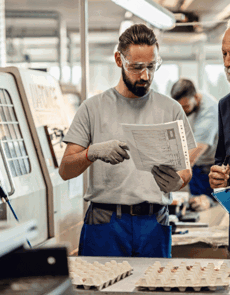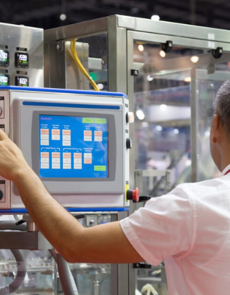The Importance of Traceability in Manufacturing and Logistics
Key Takeaways:
- Traceability helps businesses ensure quality control, compliance, and efficiency in manufacturing.
- Implementing traceability systems can help you avoid costly product recalls and pass ISO audits.
- ISO 9001 and other regulatory standards emphasise the importance of accurate traceability.
- Traceability software can improve data accuracy, streamline operations, and enhance customer satisfaction.
With increasing competitive pressures and tougher consumer demands, it is more important than ever for businesses in manufacturing and logistics to maintain customer trust and safeguard their reputation. Traceability in manufacturing plays a critical role in achieving this, enabling businesses to track and trace products throughout their lifecycle, from raw materials to the final customer delivery. By leveraging traceability systems, manufacturers can ensure product integrity, meet compliance standards, and protect against costly recalls.
What is Traceability?
Traceability has many definitions depending on the industry, but fundamentally it is the ability to quickly and efficiently track and trace the history, distribution, location and application of products, parts and materials – from suppliers and manufacturers through to assembly and final delivery to customers.
The Significance of Traceability in Manufacturing
In today’s fast-paced business environment, traceability is no longer a luxury but a necessity. It empowers companies to efficiently track product history, location and application across their entire supply chain. Chain traceability—the ability to trace each product from supplier to manufacturer to end customer—is vital for improving transparency and reducing operational inefficiencies.
Traceability is also crucial for resolving inefficiencies within production, preventing product recalls, and ensuring quality control at every step of the manufacturing process. Meanwhile, it enables businesses to manage their product history more effectively, which is crucial for meeting ISO 9001:2015 and other regulatory standards.
Who Benefits from Traceability?
Both manufacturers and their customers benefit from robust traceability systems. OEMs (Original Equipment Manufacturers) and Tier 1 suppliers require clear and transparent traceability to ensure the integrity of components and materials used in their products. For businesses, this means meeting customer expectations, safeguarding product quality, and streamlining operations.
How Traceability Resolves Inefficiencies and Prevents Recalls
Traceability is key to resolving inefficiencies in manufacturing and logistics. By eliminating information gaps and improving visibility, manufacturers can reduce delays, errors, and wasted resources. Accurate information on production capacity, supplier data, and inventory allows businesses to adjust quickly to market demands, improving customer satisfaction and delivery times.
Moreover, traceability in the supply chain is vital for preventing product recalls. When problems arise, traceability allows businesses to quickly identify affected products, minimise the damage, and protect your reputation. Having an efficient traceability process in place helps businesses act swiftly, mitigate risks, and safeguard against compliance violations and fines.
Traceability and Compliance with ISO 9001:2015
Adhering to ISO 9001:2015 standards is crucial for businesses aiming to maintain credibility and demonstrate compliance to customers and regulators. The ISO standard emphasises the need for accurate traceability through product identification and record-keeping. Specifically, it requires organisations to:
- Establish and maintain product identity throughout production
- Ensure traceability of materials from suppliers through to finished products
- Maintain detailed records of batch numbers, serial numbers, and associated data for auditing purposes
For organisations operating in regulated industries such as aerospace, automotive, and healthcare, traceability systems are essential for meeting industry-specific standards, such as AS/EN 9100 (Aviation, Space, and Defence) or ISO 13485 (Medical Devices).
Your identification system
Where appropriate, the identification system should allow for traceability from the finished product back to incoming material records and customer specifications. Products must be suitably identified by a part number or job number corresponding to applicable drawings, specifications and other technical documents related to the product.
Whether providing a service such as logistics or manufacturing physical products, BSI calls for you to “…have appropriate methods of ensuring identification and traceability of the outputs during production and service provision…"
The Role of Software in Supporting Traceability
Traceability software helps to close information gaps and streamline compliance. These systems help businesses track and manage product data in real-time, ensuring accuracy and consistency across the supply chain. By automating traceability processes, companies can reduce administrative costs and improve operational efficiency.
Traceability software also helps businesses respond faster to product recalls. Many companies see it as a form of insurance, offering peace of mind by ensuring they can demonstrate full compliance during ISO audits and prove their traceability in case of an emergency.
Examples of Traceability Across Industries
Below we explore some key examples of traceability across industries. Discover how traceability enhances transparency and accountability in different sectors, and see how you can make it work for your business.
Automotive and Aerospace:
Traceability in the automotive and aerospace industries is crucial for demonstrating product integrity and ensuring quality control at every stage of production. These sectors rely on stringent traceability systems to meet customer demands and industry regulations, such as ISO/TS 16949 and AS/EN 9100.
If you supply (or want to supply) aerospace and automotive customers, you will probably be aware of the risks faced by these industries with the supply chain. BSI Group reports risks from natural disasters, theft, and counterfeit production:
China accounts for 73% of BSI’s recorded counterfeit incidents worldwide. (BSI Intelligence)
Healthcare
In the healthcare sector, traceability is essential for managing critical products like medical devices and pharmaceuticals. With traceability systems, companies can track the movement of these products to ensure patient safety and meet standards like ISO 13485.
Food and Beverage
For food manufacturers, traceability systems help ensure the safety and quality of products by tracking ingredients from suppliers to consumers, reducing the risk of contamination and improving overall product quality.
Retail
Retailers benefit from traceability through the GS1 standards, which streamline supply chain processes and improve inventory management. This traceability system allows timely delivery of products, reduces waste, and increases customer satisfaction.
Conclusion: The Future of Traceability in Manufacturing
Have you considered:
What’s your worst-case scenario in terms of a faulty product and the effect it could have on your business? And what can you do, as far as possible, in terms of mitigation?
At this point, an investment in traceability software becomes readily justifiable. Businesses that invest in robust traceability systems not only protect their reputation but also create new opportunities for growth by improving efficiency, reducing risks, and ensuring compliance with regulatory standards. Manufacturers can gain a competitive edge, ensure quality control, and demonstrate professionalism, which ultimately leads to customer loyalty and increased business opportunities.
As manufacturing practices continue to evolve, the role of traceability will only become more critical. Companies that invest in these systems today will be better equipped to navigate the challenges of tomorrow.







